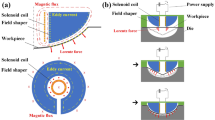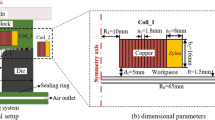Abstract
High-velocity forming (HVF) is a flexible process that can essentially enhance the forming limit of lots of low-ductility metals; however, its complicated mechanism for the deformation control hinders its wide applications. To this end, this paper introduces a data-driven methodology to uncover the nonlinear regulation of the deformation control and figure out the optimum process setting toward the preferred deformation behavior. More specifically, we adopt a newly electromagnetic-electrohydraulic hybrid forming process as the research object. Artificial neural networks are adopted to learn the process mapping between three discharge parameters (electromagnetic voltage, electrohydraulic voltage, and discharge timing) and two forming indexes (forming height and thinning rate). And then, the genetic-algorithm-based multi-objective method is used to maximize forming height, meanwhile, minimize thinning rate, and obtain the optimum process parameters. Based on such optimization, two deformation control rules are identified: (1) the greater electromagnetic voltage is preferred for better deformation uniformity; (2) the optimum discharging timing and electrohydraulic voltage are negatively correlated with each other. Based on the optimum parameter setting, the experimentations are conducted to validate such results. A 50% improvement rate on the limiting forming height is observed compared with the conventional electrohydraulic process, which is about 150% higher than the improvement rate (20.9%) obtained in our previous work, showing a substantial process improvement. In a word, the proposed method provides an effective approach for better understanding and exploiting the complicated process control mechanisms in the high-velocity forming process and its variants.









Similar content being viewed by others
Data availability
The raw data of the paper can be available by contacting the corresponding authors for academic communication.
Code availability
The codes used in the paper can be available by contacting the corresponding authors for academic communication.
References
Balanethiram VS, Hu X, Altynova M, Daehn GS (1994) Hyperplasticity: enhanced formability at high rates. J Mater Process Technol 45:595–600. https://doi.org/10.1016/0924-0136(94)9040
Shang J, Daehn G (2011) Electromagnetically assisted sheet metal stamping. J Mater Process Technol 211:868–874. https://doi.org/10.1016/j.jmatprotec.2010.03.005
Mamalis AG, Manolakos DE, Kladas AG, Koumoutsos AK (2006) Electromagnetic forming tools and processing conditions: numerical simulation. Mater Manuf Process 21:411–423. https://doi.org/10.1080/10426910500411785
Zheng Q, Yu H (2020) Hyperplasticity mechanism in DP600 sheets during electrohydraulic free forming. J Mater Process Technol 279:116582. https://doi.org/10.1016/j.jmatprotec.2019.116582
Li X, Cao Q, Lai Z, Ouyang S, Liu N, Li M, Han X et al (2020) Bulging behavior of metallic tubes during the electromagnetic forming process in the presence of a background magnetic field. J Mater Process Technol 276:116411. https://doi.org/10.1016/j.jmatprotec.2019.116411
Cheng J, Green DE, Golovashchenko SF (2017) Formability enhancement of DP600 steel sheets in electro-hydraulic die forming. J Mater Process Technol 244:178–189. https://doi.org/10.1016/j.jmatprotec.2017.01.027
Golovashchenko SF, Gillard AJ, Mamutov AV, Ibrahim R (2014) Pulsed electrohydraulic springback calibration of parts stamped from advanced high strength steel. J Mater Process Technol 214:2796–2810. https://doi.org/10.1016/j.jmatprotec.2014.01.012
Zhang Z, Lai Z, Li C, Zheng Y, Xu W, Wang Z, Li M et al (2022) Production and use of adaptive pulsed Lorentz force for multi-step electromagnetic sheet metal forming: method, experimental validation, and application. Int J Adv Manuf Technol. https://doi.org/10.1007/s00170-022-09109-z
Psyk V, Risch D, Kinsey BL, Tekkaya AE, Kleiner M (2011) Electromagnetic forming—a review. J Mater Process Technol 211:787–829. https://doi.org/10.1016/j.jmatprotec.2010.12.012
Xiong Q, Cao Q, Han X, Lai Z, Deng F, Zhang B, Zhang X et al (2016) Axially movable electromagnetic forming system for large-scale metallic sheet. Ieee T Appl Supercon 26:1–4. https://doi.org/10.1109/TASC.2016.2542480
Cantergiani E, Atieh S, Léaux F, Perez Fontenla AT, Prunet S, Dufay-Chanat L, Koettig T et al (2016) Niobium superconducting rf cavity fabrication by electrohydraulic forming. Phys Rev Accel Beams 19:114703. https://doi.org/10.1103/PhysRevAccelBeams.19.114703
Lai Z, Cao Q, Zhang B, Han X, Zhou Z, Xiong Q, Zhang X et al (2015) Radial Lorentz force augmented deep drawing for large drawing ratio using a novel dual-coil electromagnetic forming system. J Mater Process Technol 222:13–20. https://doi.org/10.1016/j.jmatprotec.2015.02.029
Gies S, Löbbe C, Weddeling C, Tekkaya AE (2014) Thermal loads of working coils in electromagnetic sheet metal forming. J Mater Process Tech 214:2553–2565. https://doi.org/10.1016/j.jmatprotec.2014.05.005
Cao Q, Han X, Lai Z, Xiong Q, Zhang X, Chen Q, Xiao H et al (2015) Analysis and reduction of coil temperature rise in electromagnetic forming. J Mater Process Technol 225:185–194. https://doi.org/10.1016/j.jmatprotec.2015.02.006
Bonnen JJF, Golovashchenko SF, Dawson SA, Mamutov AV (2013) Electrode erosion observed in electrohydraulic discharges used in pulsed sheet metal forming. J Mater Eng Perform 22:3946–3958. https://doi.org/10.1007/s11665-013-0690-0
Chen M, Lai Z, Cao Q, Han X, Wang C, Liu N, Li L (2020) Improvement on formability and forming accuracy in electromagnetic forming of deep-cavity sheet metal part using a dual-coil system. J Manuf Process 57:209–221. https://doi.org/10.1016/j.jmapro.2020.06.023
Ouyang S, Wang C, Li C, Li X, Lai Z, Peng T, Han X et al (2021) Improving the uniformity and controllability of tube deformation via a three-coil forming system. Int J Adv Manuf Technol 114:1533–1544. https://doi.org/10.1007/s00170-021-06959-x
Ahmed M, Shrivastava A, Kumar DR, Nabi MU (2020) Optimisation of process parameters for energy-efficient electro-hydraulic forming of Al-Mg alloy sheets. Adv Mater Process Technol 6:620–636. https://doi.org/10.1080/2374068X.2020.1731228
Choi MK, Huh H, Park N (2017) Process design of combined deep drawing and electromagnetic sharp edge forming of DP980 steel sheet. J Mater Process Technol 244:331–343. https://doi.org/10.1016/j.jmatprotec.2017.01.035
Zohoor M, Mousavi SM (2018) Evaluation and optimization of effective parameters in electrohydraulic forming process. J Braz Soc Mech Sci. https://doi.org/10.1007/s40430-018-1449-1
Keshtiara M, Golabi SI, Tarkesh Esfahani R (2021) Multi-objective optimization of stainless steel 304 tube laser forming process using GA. Eng Comput-Germany 37:155–171. https://doi.org/10.1007/s00366-019-00814-0
Alnaqi AA, Moayedi H, Shahsavar A, Nguyen TK (2019) Prediction of energetic performance of a building integrated photovoltaic/thermal system thorough artificial neural network and hybrid particle swarm optimization models. Energ Convers Manage 183:137–148. https://doi.org/10.1016/j.enconman.2019.01.005
Kahhal P, Jung J, Hur YC, Moon YH, Kim JH (2022) Neural network-based multi-objective optimization of adjustable drawbead movement for deep drawing of tailor-welded blanks. Materials 15:1430. https://doi.org/10.3390/ma15041430
Li C, Lai Z, Wang C, Gao Y, Wang Z, Cao Q, Han X et al (2022) Toward better metal flow control in electrohydraulic sheet forming by combining with electromagnetic approach. J Mater Process Technol 299:117343. https://doi.org/10.1016/j.jmatprotec.2021.117343
Ding S, Su C, Yu J (2011) An optimizing BP neural network algorithm based on genetic algorithm. Artif Intell Rev 36:153–162. https://doi.org/10.1007/s10462-011-9208-z
Funding
This work was supported by the National Natural Science Foundation of China (52107150, 52077092, 51821005, and 51877122) and the Fundamental Research Funds for the Central Universities (HUST: 2020kfyXJJS055).
Author information
Authors and Affiliations
Contributions
All authors contributed to the study’s conception and design. Material preparation, data collection, and analysis were performed by Ziye Wang, Zhipeng Lai, and Changxing Li. The first draft of the manuscript was written by Ziye Wang and Zhipeng Lai, and all authors commented on previous versions of the manuscript. All authors read and approved the final manuscript.
Corresponding authors
Ethics declarations
Ethics approval
We declare that ethical and professional conduct has been followed in our research.
Consent to participate
Not applicable.
Consent for publication
We declare our consent for publication.
Competing interests
The authors declare no competing interests.
Additional information
Publisher's Note
Springer Nature remains neutral with regard to jurisdictional claims in published maps and institutional affiliations.
Rights and permissions
About this article
Cite this article
Wang, Z., Lai, Z., Li, C. et al. Data-driven method for process optimization in electromagnetic-electrohydraulic hybrid high-velocity sheet metal forming. Int J Adv Manuf Technol 121, 4355–4365 (2022). https://doi.org/10.1007/s00170-022-09621-2
Received:
Accepted:
Published:
Issue Date:
DOI: https://doi.org/10.1007/s00170-022-09621-2




